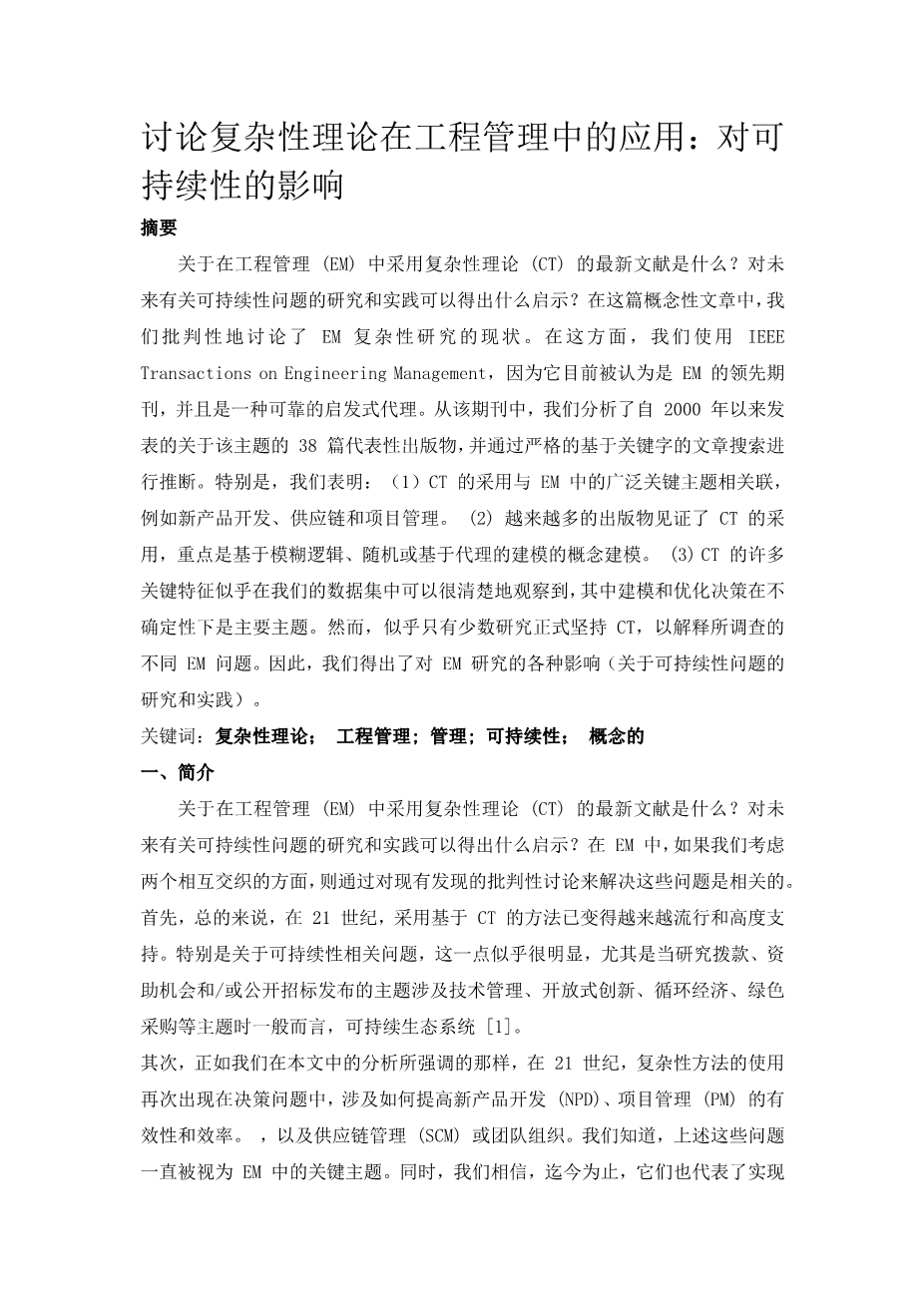Discussing the Use of Complexity Theory in Engineering Management: Implications for Sustainability
Abstract
What is the state-of-the-art literature regarding the adoption of the complexity theory (CT) in engineering management (EM)? What implications can be derived for future research and practices concerning sustainability issues? In this conceptual article, we critically discuss the current status of complexity research in EM. In this regard, we use IEEE Transactions on Engineering Management, because it is currently considered the leading journal in EM, and is as a reliable, heuristic proxy. From this journal, we analyze 38 representative publications on the topic published since 2000, and extrapolated through a rigorous keyword-based article search. In particular, we show that: (1) the adoption of CT has been associated with a wide range of key themes in EM, such as new product development, supply chain, and project management. (2) The adoption of CT has been witnessed in an increasing amount of publications, with a focus on conceptual modeling based on fuzzy logics, stochastic, or agent-based modeling prevailing. (3) Many key features of CT seem to be quite clearly observable in our dataset, with modeling and optimizing decision making, under uncertainty, as the dominant theme. However, only a limited number of studies appear to formally adhere to CT, to explain the different EM issues investigated. Thus, we derive various implications for EM research (concerning the research in and practice on sustainability issues).
Keywords: complexitytheory; engineeringmanagement; management; sustainability; conceptual
1. Introduction
What is the state-of-the-art literature regarding the adoption of the complexity theory (CT) in engineering management (EM)? What implications can be derived for future research and practices concerning sustainability issues? In EM, addressing these questions through a critical discussion of extant findings is relevant if we consider two, intertwined aspects.
First, in general, the adoption of approaches based on CT has become, in the 21st century, increasingly popular and highly supported. Concerning sustainability related issues, in particular, this is seemingly evident, especially when research grants, funding opportunities, and/or public tenders are released on themes regarding, for example, technology management, open innovation, circular economy, green procurement, or, more generally, sustainable ecosystems [1].
Second, as also highlighted by our analysis in this article, in the 21st century, the use of complexity approaches recurs in decision-making problems, regarding how to improve the effectiveness and efficiency of new product development (NPD), project management (PM), and supply chain management (SCM), or team organization. We know that these aforementioned problems have always been considered as key themes in EM. At the same time, we are confident that, to date, they also represent key challenges towards more sustainable business models [2].
As an example, in addressing a central issue for technology management research, i.e., understanding the nature of the industry environments in which firms play, Ndofor et al. [3] argue that “if the microfoundations of industry environments are indeed strongly impacted by nonlinear relationships, then the industry environment would evolve with chaotic dynamics, as opposed to equilibrium systems” (p. 200). Relatedly, as maintained by McCarthy et al. ([4], p. 437), “early research on NPD has produced descriptive frameworks and models that view the process as a linear system with sequential and discrete stages. More recently, recursive and chaotic frameworks of NPD have been developed, both of which acknowledge that NPD progresses through a series of stages, but with overlaps, feedback loops, and resulting behaviors that resist reductionism and linear analysis.”
In the same vein, as stated by Amaral and Uzzi ([5], p. 1034), “a design engineer may know about the reliability of individual parts but find it difficult to estimate how failures in one part of system are tied together or how errors might cascade through the system when apparently separate components have a low probability of failure.” Likewise, as posited by Baumann and Siggelkow ([6], p. 116), “should a product design team always consider all components simultaneously, searching for designs that have high overall performance? Or should it first experiment with a subset of components and expand this set gradually in the course of the design process?”
On this premise, starting in the 1960s, several contributions to CT have arisen from various science disciplines, such as biology, mathematics, physics, chemistry, and information technology [7,
英语译文共 25 页,剩余内容已隐藏,支付完成后下载完整资料
lt;a data-cke-saved-href='https://www.mdpi.com/2071-1050/
资料编号:[602698],资料为PDF文档或Word文档,PDF文档可免费转换为Word
您可能感兴趣的文章
- 饮用水微生物群:一个全面的时空研究,以监测巴黎供水系统的水质外文翻译资料
- 步进电机控制和摩擦模型对复杂机械系统精确定位的影响外文翻译资料
- 具有温湿度控制的开式阴极PEM燃料电池性能的提升外文翻译资料
- 警报定时系统对驾驶员行为的影响:调查驾驶员信任的差异以及根据警报定时对警报的响应外文翻译资料
- 门禁系统的零知识认证解决方案外文翻译资料
- 车辆废气及室外环境中悬浮微粒中有机磷的含量—-个案研究外文翻译资料
- ZigBee协议对城市风力涡轮机的无线监控: 支持应用软件和传感器模块外文翻译资料
- ZigBee系统在医疗保健中提供位置信息和传感器数据传输的方案外文翻译资料
- 基于PLC的模糊控制器在污水处理系统中的应用外文翻译资料
- 光伏并联最大功率点跟踪系统独立应用程序外文翻译资料



